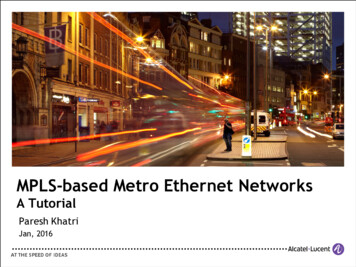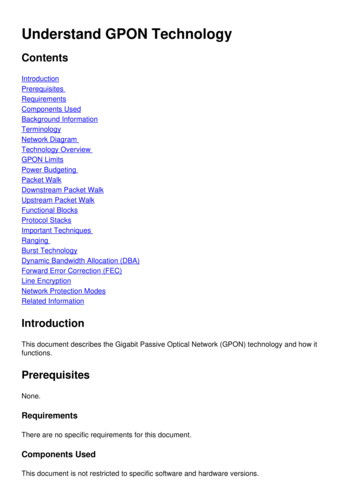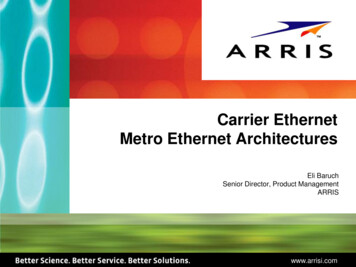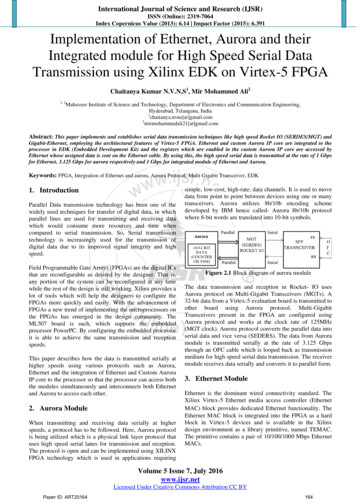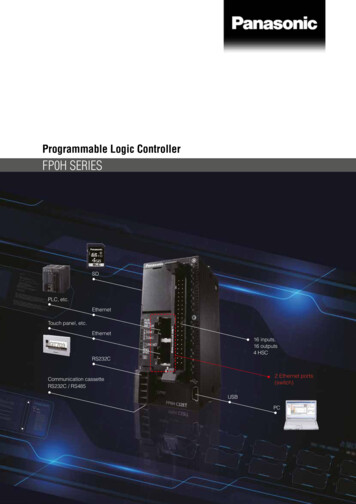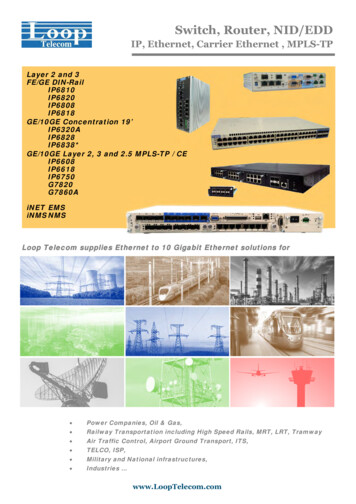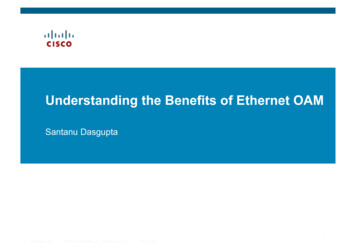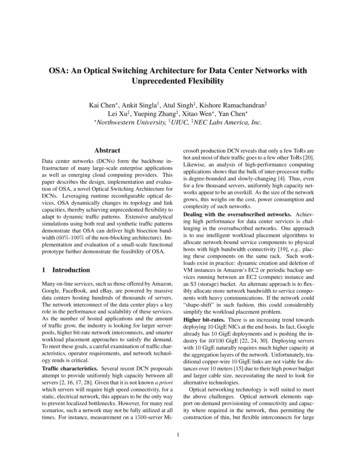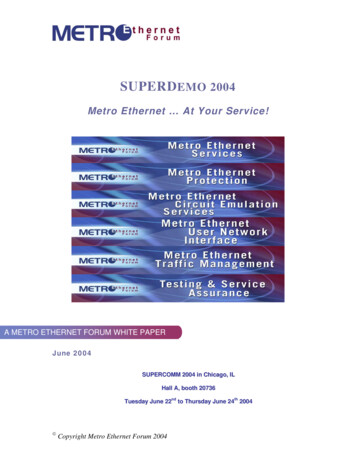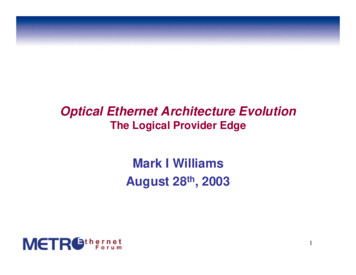
Transcription
Optical Ethernet Architecture EvolutionThe Logical Provider EdgeMark I WilliamsAugust 28th, 20031
Agenda OE Introduction and Drivers VPLS – The technology behind theService Decoupled VPLS – Providing Scalableand Affordable VPLS Services Summary2
What is Optical Ethernet?Ethernet Ubiquity Flexibility SimplicityCombined WithMetro AreaNetworkOptics Reach Scale ReliabilityFast Simple ReliableExtend the boundaries of the LAN to encompass the MAN & WAN3
Global Optical Ethernet Service RevenueGlobal Optical Ethernet Services Revenue30000US Millions2500020000Global OE ServiceRevenue1500010000500002001 2002 2003 2004 2005 2006Source: IDC 20034
Success is in the PlugServiceProviderEthernet ConnectionInterfaces readily used todayNetwork switches & routersComputers & Peripheralsi-appliancesNetwork-Based ServicesServices customers will buyConnectivityApplicationsContent & EntertainmentTelephonyOutsourced servicesSimplicity at the edge5
OE Enterprise Value Propositions Reduce IT cost and risk by simplifying the Network Reduced dependence on IP routing & complexity Increase the available bandwidth over the network to‘LAN’ levels Enable high data volume applications such as multimediastreaming to be deployed across a wide area Extend the reach of the Campus network across wide area Improve the reliability of the network Carrier-grade OE enables critical applications like DisasterRecovery and Data Centre connectivity6
OE Carrier Value Propositions Improve Enterprise customer business via OEservices Increase revenue by delivering new services Deliver the Enterprise Value Propositions in previous chartLayer 2 VPNs, Multi-media streaming Reduce the Capex and Opex of delivering carrierservices OE infrastructure in conjunction with traditional IP & MPLSinfrastructure7
Carrier OE ServiceTransparent LAN Service Extending LANs into the Metro and beyond Upsell or replace leased line data services Speed of Ethernet with the Reliable andIntegrity of leased lineTransparent LAN TunnelEdgeSwitchEthernetService ProviderEdgeSwitchShanghaiBejingTargeted at Business Users !8
Carrier OE ServiceManaged LAN Service Multi-point LAN and network topology Combine both L2 and L3 VPN service offeringsServiceProviderOpticalEthernetCustomer Site 1TaipeiEdgeSwitchCustomer Site 2BejingCustomer Site 4Hong elWorkeru nTravellingTecSISPdial-inPII PSeInternetc Tunn elHome WorkerCable / DSLEnable Enterprise Outsourcing9
VPLS – The Technology Behind theService10
OE Virtual Private LAN Service (VPLS) TypesEthernet Point-to-Point ‘Wholesale’ connectivity (POP-to-POP,data centre interconnect, virtual colo) Alternative for leased linesCustomerbridge/routerOE NetworkEthernet Point-to-Multi-Point ‘Retail’/”Wholesale” OE services Switching based on 802.1Q VLAN tag Alternative for FR, ATM, OE NetworkEthernet Any to Any ‘Retail’ OE services to enterprise Ethernet LAN extension over themetro/WAN Alternative for IP VPNOE Network11
Network Reference Model for PPVPNBackbone Tunneling MPLS/GMPLS/IPSec/GREPVPN ACEPVPN APECEPECEVPN BCEBackboneVPN BCEPEPVPN CVPN CPCECECEVPN DCE - Customer Edge DeviceSwitchCEVPN DPE - Provider Edge DeviceP - Provider Internal DeviceCE"Provider Provisioned VPNs": VPNs for which the Service Provider12(SP) participates in management and provisioning of the VPN.
Decoupled VPLSProviding Scalable and Affordable VPLS Services13
VPLS ArchitecturesEdge-to-edge MPLS MPLS is deployed all the way betweenService Provider EdgesDecoupled Models PE-Edge in the buildings –Transport Network(EoX, Others)- (MPLS Enabled) PE-Core –MPLS Backbone 802.1Q at Edge & Aggregation Network withMPLS core: i.e. decoupled model with a“dumb Edge”14
VPLS ArchitecturePartial Bridge – MPLS edge-edgeMPLS BackbonePseudowires (Martini)EmulatedLANPEVPLS ForwarderEmulated LAN InterfaceIEEE BridgeAccessAttachmentCircuitsCE Devices: Hosts, Routers, Bridges15
VPLS ArchitectureEdge to Edge MPLSMartini EncapsulationHQPPE1MAC Learning,ReplicationPE3MPLSPPRSVP-TE TunnelsFor “MPLS Fabric”LDP-DU (BGP-MP)for VPLS Control PlaneCE2PE2 RouterEthernetFrameControlWord (CW)VCLabelTunnelLabelLocalTEHeaderLabel EthernetSwitchSame Martini Encapsulation16
Decoupled VPLS ArchitectureDecoupled Partial BridgeMPLS BackbonePseudowires (Martini)N-PEVPLS ForwarderPEAccessNetworkEmulated LAN InterfaceU-PEIEEE BridgeAccessAttachmentCircuitsCE Devices: Hosts, Routers, Bridges17
Why Use A Decoupled Model?ECONOMICS MPLS down to the SP Edge Increases cost– Expensive PE in Buildings: (10,000s vs 100s) * 1000sof PEs– Complex Protocol Stack in the “Building” PE MPLS ! Complexity ! Cost– Bandwidth Loss - Multicast Replication in buildings too close to the source ! too many copies in the networkOver 50% of the cost is In-Building EquipmentSimplicity here is an absolute must!18
Why Use a Decoupled Model?MPLS SCALING PPVPN Model requires a full-mesh of MPLS tunnels between PEs.MPLS Edge-Edge requires 1 PE per buildingDecoupled Model Requires 1 PE per 100s of buildings.Example: China-Wide Network, 100,000 buildings.– MPLS edge-edge: 100,000*99,999 LSPs 10 billion LSPs.– Decoupled VPLS: 1,000*999 LSPs 1 Million oneCOYou Could Not Build a China-Wide VPLS Networkwithout using a Decoupled VPLS Model19
VPLS Decoupled ModelsBuilding BlocksPEEthernet SwitchedNetworkN-PE - Provider Edge DeviceESNESNMPLSU-PE - PE Edge DeviceU-PEN-PEU-PEVPN APCECEESNCEVPN AU-PEMPLSESNN-PEVPN BCEU-PEVPN BPPPCEN-PEU-PEVPN CFlexible Deployment Model: N-PE to U-PE - choice ofDirect Link or different Ethernet Switched NetworksSwitchCE 20
4 Examples of Decoupled VPLS Today DTLS – Decoupled TLS–draft-kompella-ppvpn-dtls-02.txt HVPLS – Heirarchical VPLS–draft-lasserre-vkompella-ppvpn-vpls-04.txt Logical PE–draft-ouldbrahim-l2vpn-lpe-02.txt GVPLS – Generic VPLS solution–draft-radoaca-ppvpn-gvpls-02.txt21
DTLS - Distributed PE (D-PE)L2PEVPN APCEESNCEPEVPN BL2PEMPLSMPLSL2PEVPN BCEPCEPVPN ACEPPEL2PEVPN C Divide the PE into PE and L2PE––––––PE runs MPLS-TE across the core MPLS networkPE knows about VPLS instances, but not about MAC addresses.Recommended that all provisioning be done on PE, distributed to L2PE by protocol.L2PE is mostly a L2 device only. (L3 simple and used by control plane only.L2PE acts as L2 bridge and sends encapsulated packets across pseudowire to PE.Encapsulation can be MPLS or stacked VLANs Core transport uses Martini Encapsulation or any other tunnel (GRE, IPSec, etc) PE uses BGP for membership discovery across core. Broadcast/Multicast replication at source L2PE22
H-VPLS - H-PEMTU-sVPN ACEPCEESNCEPE-rsVPN BVPN BCEPCEMTU-sMTU-sMPLSMPLSPVPN APPE-rsMTU-sVPN C Divide the PE into PE-rs and MTU-s– PE runs MPLS-TE across the core MPLS network– PE-rs learns MAC addresses and contains virtual bridging function.– MTU-s aggregates VPLS ports onto a single PW per VPLS to PE-rs– Encapsulation can be MPLS or stacked VLANs Core transport uses Martini Encapsulation, GRE, IPsec, etc. PE uses LDP for membership discovery across core. Broadcast/Multicast replication at source and dest PE-rs and23dest MTU-s
Logical Provider Edge (L-PE)PE-EdgeVPN APCEESNCEPE-CoreVPN BVPN BCEPCEPE-EdgePE-EdgeMPLSMPLSPVPN ACEPPE-CorePE-EdgeVPN C Divide the PE into PE-Core and PE-Edge–––––PE-Core runs MPLS-TE across the core MPLS networkPE-Core knows about VPLS instances, but not about MAC addresses.Recommended that all provisioning be done on PE-Edge, distributed to PE-Core by protocol.PE-Edge is a L2 device only. (L3 used by control plane only)PE-Edge acts as L2 access multiplexer and sends encapsulated packets across Ethernet toPE-Core– Encapsulation can be Mac-in-Mac or MPLS Core transport uses Martini Encapsulation or any other tunnel (GRE, IPSec, etc) PE-Core uses LDP for membership discovery across core. Broadcast/Multicast replication as close to destination as possible.24
MAC Learning: ngVLAN Stacking and Denial of Service Attacks, MAC ExplosionN-PEPN-PEU-PEU-PE?3-10s sites1000s-10,000VPNs?10,000s VPNs1000s-10,000VPNs3-10s sitesH-PE forces MAC Learning in the N-PE But still protects network core25
MAC Learning: D-PE and gVLAN StackingD-PE and L-PEN-PEPN-PEU-PEMACLearningOnly in 3-10s sitesPE-E1000s-10,000VPNsU-PE10,000s VPNs1000s-10,000VPNs3-10s sitesDistributes MAC Learning to U-PE - Contains the effects of DoS Attacks.26
Technology Choices for Decoupled ModelsBcast/Mcast ReplicationN-PEU-PEN-PEU-PEMPLSMulticast flow destined to 3 UNIs located on the same destination PE-E.Wasted Bandwidth in the MPLS Backbone! (D-PE)N-PEU-PEN-PEMPLSU-PEReplicate as close to the destination as possible.Maximum Bandwidth Savings (H-PE and LPE)27
GVPLS Model28
Objectives of GVPLS Key goal is to support seamless integration of decoupledand all non-decoupled VPLS models– Same signaling mechanism– Same auto-discovery mechanism– Same provisioning model Allow integration of different access topologies – acrossService Provider network:– Hierarchical PE– Distributed PE– With different technologies SET (MAC-in-MAC), P2P, P2MP, Q-in-Q etc.29
TOWARD a UNIFIED VPLS SolutionGVPLS-CommonCommonCommonCommonDPE-U-PE-sf devices-SET Encapsulation-Martini-MAC-in-MAC-- MPLS coreDTLS and LPE implement DPEInformation ModelSignaling ModelDate PlanAuto-discovery model-Rosen L2 signaling draft-Nortel/Cisco BGP Autodiscovery-Martini Encapsulation draftHPE-U-PE-s devices-SET Encapsulation-Martini-Q-in-Q-VLAN-- MPLS coreHVPLS implements HPE30
A Closer Look at the Metro TransportMetro TransportNetworkU-PEMPLSN-PE31
Metro L2 Transport Mechanisms Stacked VLANs (Q-in-Q)– VLAN stacking provides simple servicedelineation cost effectively– Limited scalability– Exposes Core Network to ALL CustomerAddresses802.1QTag Payload OE Header (MAC-In-MAC– Encapsulate entire frame into Service ProviderEthernet packet– Customer MAC addresses, VLAN and QoStransparently transported without affectingoperator’s networkOE CustomerHeader Frame MPLS Labels (Pseudowires)– Leverage emerging connection-orientatedstandard for interoperability– Incorporate values of “fast, simple, reliable”MPLS CustomerLabelsFrame32
Comparing Metro Access oorGoodGoodScalabilityPoorGoodGoodCan have Directconnect acrossAccess net?YesYesNoMedia Agnostic?NoNoYesSimple edgeswitch?YesNoNoEach Method Has its Place33
Summary Optical Ethernet and VPLS Services meet a significantEnterprise service requirement OE Service Revenue projected to grow at an annual rateof 120% from 2001 to 2006 (IDC) Asia Pacific will lead the investment with over 50% ofrevenues between now and 2007 (IDC) A Basic Technology behind these services is the L2 VPNbased on MPLS core transport. The only way to affordably scale this infrastructure is byusing a Decoupled VPLS technology. IETF is in advanced stages of drafting specifications fordecoupled VPLS and multiple IETF-basedimplementations are in the market today.34
www.MetroEthernetForum.org35
Optical Ethernet Architecture Evolution The Logical Provider Edge Mark I Williams August 28 th, 2003. 2 Agenda OE Introduction and Drivers . Ethernet LAN extension over the metro/WAN Alternative for IP VPN Customer bridge/router OE Network OE Network OE Network. 12 Backbone VPN A VPN B VPN D VPN A VPN B VPN D PE PE PE CE CE CE CE .
